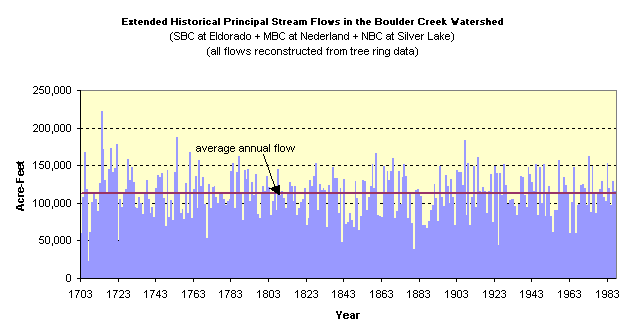
The above graph shows the combined natural flows of the Boulder Creek
watershed's three principal streams - South Boulder Creek at Eldorado
(SBC), Middle Boulder Creek at Nederland (MBC) and North Boulder Creek
at Silver Lake (NBC) - over the period of 1703 through 1987.
These flows are based upon
reconstructed flow data for MBC, derived from tree ring data by Dr.
Connie A. Woodhouse (Institute of Arctic and Alpine Research, University
of Colorado). The reconstructed MBC flow data were extended to the other
two locations using correlation studies. This
work was done by Hydrosphere as part of an ongoing project for the City
of Boulder.
It should be noted that
the graph shows only reconstructed flows and does not reflect actual
recorded flows for the more recent period of recorded history (generally
1906 onward). This was done in order to illustrate the relative magnitude
of low flow periods over the entire 285- year sequence in a correct
manner. Thus, while the graph does not accurately depict actual flows
during the 1953-1956 drought (they were lower than shown), it does accurately
compare the relative severity of the 1950s drought to other droughts
as evidenced by the tree ring data.
We can therefore confidently
infer that the droughts of the 1840s and 1880s were more severe than
that of the 1950s in terms of stream flow in the Boulder Creek watershed.
1.
1 The reconstructed MBC flow data were extended to the other two
locations by developing linear regression equations that quantified
the correlations between recorded gage flows at MBC and calculated natural
flows at the other two locations. Hydrosphere Resource Consultants had
previously developed natural flow data for SBC and NBC. The correlations
between annual flows at MBC and the two other locations are strong,
explaining 83% of the variability at SBC and 91% of the variability
at NBC. However, the correlations aren't perfect, so we added a random
component to each of the regression equations that captures some of
the uncertainty. The random component in each equation is equal to the
standard deviation of the residuals for that equation times a normally
distributed random number with mean of zero and standard deviation of
one. This approach mimics the "error" seen in the regression equations
and prevents all of the inflows from having perfect correspondence.
Return
to Drought, Fire and Flood Homepage
Drought
- Fire - Flood
- It's All Connected